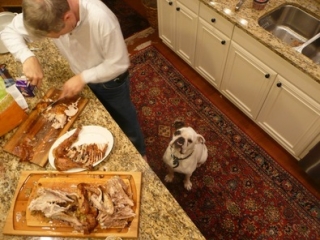Thanksgiving...Holiday Hazards

With the holidays rapidly approaching, keep in mind that your stress and changes in routine can have an impact on your dog's behavior. They may "act out" if they sense our frustrations and the typical attempts to get our attention fail. This can be avoided by maintaining some of your daily routines, like mealtime and a long walk. In addition to keeping things “normal” for Fido, also try to make sure he has a quiet retreat, like a bedroom or his crate, just in case he wants to get away from your niece who wants to play dress up or Uncle Fred’s cigars.
There are some holiday-hazards to watch for, which can be harmful to your dog. There are quite a bit of yummy things pets can (and will) try to eat. All those delectable treats we love so much this time of year can be very harmful, even fatal to our furry friends. Turkey can be upsetting to your dog’s digestive system, as tryptophan (that stuff in turkey which makes us sleepy) can often cause diarrhea. I tend to keep a few cans of plain pumpkin on hand during the holidays to mix into the dog food when they’ve had some special treats. A couple of tablespoons of pumpkin can help to ease an upset tummy. The other danger with the turkey is of course the bones. Cooked bones are brittle and can splinter, and they are not easily digested. Take extra care to keep the cooked turkey out of Fido’s reach!
Chocolate can be extremely toxic to dogs and cats. Chocolate contains a substance called theobromine, which cannot be metabolized readily by most dogs. Baker’s chocolate has the highest concentration of theobromine, and is therefore more dangerous than semi-sweet, which is in turn more dangerous than milk chocolate. So even if your dog ate a few M&Ms and was okay, that doesn’t mean he can eat a batch of mom’s homemade brownies and survive. Symptoms of chocolate toxicity may include some or all of the following symptoms: Moderate to severe vomiting or diarrhea, excitability and nervousness, muscle tremors and/or seizures, heart failure (death).
Holiday plants are also toxic to pets, primarily dogs, specifically Holly (berries), Mistletoe (all), and Poinsettia (all). Symptoms of Holly poisoning include digestive upset and/or central nervous system depression. If your pet eats mistletoe, you may see any, or all, of the following symptoms: digestive upset, depression, exhaustion, coma, heart failure (death). Poinsettia causes digestive upset and/or irritation to the mouth & stomach lining. Poinsettia sap is also irritating to the skin. Other plants or decorations may be sprayed or treated with a chemical or perfume, which may also be toxic.
If your dog (or cat) ingests one of these plants or chocolate, and is alert, it is best to get it out of his system. To induce vomiting in a dog, place a teaspoon full of table salt on the very back part of his tongue, and confine him to an area you can easily clean. For cats, use one-half of a teaspoon (and good luck getting it in there, try putting the salt into a straw to get it further back in the cat’s mouth). Within a few minutes, he should empty his stomach of everything he has eaten in the previous few hours. Clean it up promptly so he doesn’t try to eat it again. Once you have started this process, or if your dog is not alert, call your veterinarian or animal emergency clinic immediately. Let them know what happened and exactly what symptoms your pet is experiencing.
As you begin decking the halls and trimming the tree: some pets will eat Christmas tree ornaments and/or tinsel. Tinsel, like glass, can slice through the lining of as animal’s digestive tract. It can also wrap around the intestines and cause a blockage. If this happens, the treatment is simple. First, call your veterinarian and tell him or her how much and what exactly your pet ate. The preferred course of action, for small amounts of glass or tinsel, is feeding the animal white bread soaked in half and half (you may want to keep a small carton of half and half in the freezer). A large dog (over 65 lbs) would need 7-8 slices of bread. As the bread travels through the animal’s digestive tract, it should surround the foreign bodies and help them to pass without incident. You must watch the animal’s stool for blood. If you see blood in the stool, call your vet immediately.
[photo by Campbell's Soup - via Google search]




